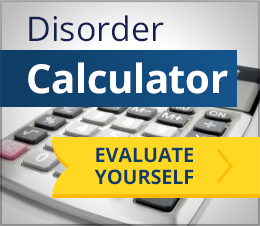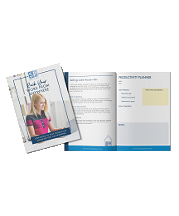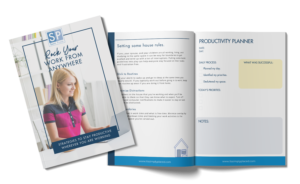
One of the topics we are often asked to consult with our clients on is selecting a time and task management system that helps them track, remember and maintain control over what they need and want to do. Simply Placed Professional Organizer and Productivity Consultant Dana Diaz shares some of her thoughts and experiences in doing so in this post.
Finding a comprehensive time and task management system to manage your to-dos and schedule can be difficult. What’s the best way? Some cool new mobile app, or good old pen and paper? Maybe even a combination of the two? Well, the answer depends on your existing habits and personal preferences.
The best type of system is the one that works for you; the one that’s easiest to use and one you don’t have to think twice about.
For some of us, that may be a paper planner. For others, maybe it’s an electronic calendar and task app on your laptop. Today, smart phones are usually the most-used device, so maybe the best solution is one that’s an easy to use a mobile app. In the end, the the best system is one you will actually use without much extra thought or friction.
Whatever system you use to manage your time and tasks, it should include a few key elements, such as:
- a documented master list of all of your tasks or to-dos, regardless of when they may need to be done.
- a way to keep track of your “micro” (daily/weekly) schedule and your “macro” (monthly/yearly) schedule
Your daily schedule is the basis for your time and task management system. It keeps you on task, reminds you of your priorities and appointments and commitments you’ve made to others. Weekly schedules are helpful if you have a diverse workload and different activities on different days. Monthly and yearly schedules are important if you have one-time or recurring appointments (i.e. dentist, oil change, etc.) that you plan ahead.
Time to review your schedule (both what you’ve accomplished and done in the past, as well as plans for the upcoming period) and block time for priorities regularly are key activities to the success of your chosen tool.
Observe your natural habits to see what fits you best
To figure out which system or systems work best for you, start by observing your natural behaviors. Do you check your phone first thing in the morning? Do you check work email more often than texts or calls on your mobile device? Is your workstation surrounded with reminders written on sticky notes or little scraps of paper? Do you have a lot of daily or weekly recurring tasks, or one-time appointments?
Is Digital Best for You?
I used to prefer writing down all of my to-dos and appointments in a physical planner. Now, though, I realize the benefits and ease that come with digital time and task management systems. Since I am frequently on my phone, implementing a mobile app system was the best solution for me. The best part is having access to my to-do list and calendar wherever I am, as long as I have my phone.
Another benefit of digital systems is their ability to make recurring tasks a breeze. Rather than writing the same task in your planner each week, you can set a digital task to recur on specific days and at specific times. You can also set notifications on your device to remind you when to do them. Enter something once, set it to reoccur with the appropriate frequency, and you’re done. No more having to re-enter that weekly team meeting each week or your all birthdays of those you care about each year.
Do you love the tactical feel of turning pages and writing on paper?
If you have and love handwritten reminders, a planner or a paper calendar and daily to-do list is probably your most useful system. Planners are great because they include daily/weekly/monthly/yearly calendars all in one. If you use a planner, the most important rule to remember is to write everything in it!
One potential downfall of a paper-based time and task management systems is writing things down in places other than your chosen system. In doing so, you risk having a disconnect and missing something you’ve scheduled. If you’re using a planner, make sure to write all of your appointments and notes in it – not on individual scraps of paper. The same goes for a written daily to-do list—make sure you only have one list! Another potential downfall is not taking your paper-based system where ever you go. Ensure you have it with you so that you can add new appointments, to-dos or ideas as they come to you.
The best system is the one you’ll use
For many people, using their chosen calendar as their task management system is a win. They’re already in the habit of reviewing their calendar regularly for appointments, so entering tasks as appointments with themselves works.
Once you figure out how you most naturally keep track of your micro (daily/weekly) and macro (monthly/yearly) schedules whether digitally or with good old pen and paper, you can then plug tasks or activities from your master to-do list into timeslots in your daily, weekly, or monthly calendars depending on the task or appointment.
Some tasks, like a weekly meeting or a dentist appointment, easily fit into a timeslot in a calendar. Some tasks may not have an exact timespan or deadlines but still need to be assigned a time slot. When a task has an associated due date, you are more likely to get it done than if it just lives perpetually on your master to-do list.
It is also very helpful to look at and update your daily/weekly schedules and master to-do list daily. Some people find it easier to organize their tasks and set up their daily schedules in the evening for the next day. Others prefer to start off their day by organizing their schedule and deciding on competing priorities first thing in the morning. This is personal preference and neither is right or wrong.
The best type of system is the one that works for you; the one that’s easiest to use and one you don’t have to think twice about.
Keys to Success
Regardless of how and when you keep up with your time and task management system, the most important things to remember are
- Use ONE system
- Have a master task list. Regularly review that list for time sensitivity, plugging tasks into your micro (daily/weekly) schedule or time-based task management system.
- Review on a macro (monthly/yearly) level regularly as well. Make sure that no future and recurring appointments fall through the cracks.
Building a system that works for you
If you would like to learn more about time and task management systems, we would love to work with you. We’ll connect one-on-one to learn your habits and build a system that works for you. Schedule your initial consultation call with Simply Placed today!






